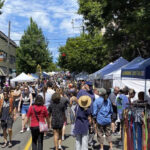Green Streets represent an innovative and environmentally conscious approach to managing stormwater in urban environments. Instead of simply channeling rainwater away, green streets are designed to mimic natural processes, utilizing vegetation, soil, and carefully engineered systems to slow down, filter, and cleanse stormwater runoff directly at its source. This method contrasts sharply with traditional street designs that quickly divert rainwater from impervious surfaces like roads and sidewalks into storm sewer systems, which then discharge directly into rivers and streams, often carrying pollutants.
To understand the effectiveness and broader benefits of green streets, resources like the EPA’s video, “Green Streets: The Road to Clean Water,” offer valuable insights. This video showcases real-world examples of how communities, in partnership with the EPA, have successfully integrated green streets into their stormwater management strategies. These examples highlight diverse green features such as permeable pavements that allow water to seep into the ground, rain gardens that naturally filter runoff, vegetated curb extensions that capture and treat water, and sidewalk trees that provide shade and absorb rainwater.
Delving into the Anatomy of a Green Street
Considering that streets constitute a significant portion of public land in most urban areas, they present a remarkable opportunity to implement green infrastructure. Incorporating green street elements is not just about environmental protection; it’s also about enhancing community well-being and fostering urban prosperity.
The design of green streets is multifaceted, incorporating a range of elements such as street trees for canopy cover and water interception, permeable pavements to facilitate infiltration, bioretention systems to filter pollutants, and swales to manage water flow. The key to a successful green street lies in maximizing the contact between stormwater, soil, and vegetation, promoting infiltration and on-site retention. While the aesthetic and specific design of green streets can vary widely to suit different urban contexts, their core functional goals remain consistent:
- To provide source control for stormwater, thereby minimizing the transportation of pollutants into stormwater conveyance systems.
- To restore the natural pre-development water cycle (hydrology) as much as possible within the urban setting.
- To create road systems that actively contribute to environmental protection and the improvement of local water quality.
Understanding the specific components of these sustainable urban features is crucial. The “Anatomy of a Green Street” design graphic below provides a detailed visual breakdown of these elements. For those looking to delve deeper into the technical aspects and best practices of green street design and implementation, the Low Impact Design Center serves as an excellent resource. They offer a wealth of publications and resources that support innovative green street design-build approaches, further detailed in resources about Design-Build concepts.
The Compelling Reasons for Green Streets
The adoption of green streets brings forth a multitude of benefits, most notably in the realm of water quality. Green streets are highly effective at protecting the health of rivers and streams by removing up to 90% of pollutants from stormwater runoff. Beyond water purification, they play a crucial role in replenishing groundwater reserves, acting as carbon sinks to absorb atmospheric carbon dioxide, and improving overall air quality within urban neighborhoods. Furthermore, the integration of greenery enhances neighborhood aesthetics and establishes vital green corridors connecting parks and open spaces, enriching urban biodiversity. Vegetated curb extensions, a common feature in green street designs, also contribute significantly to pedestrian and bicycle safety and help to naturally calm traffic speeds, making streets safer for all users.
Economically, green streets offer substantial advantages. By reducing peak stormwater flows, they alleviate pressure on existing sewer systems, freeing up capacity for wastewater management and significantly decreasing the risk of sewer backups in residential basements. In many cases, implementing green streets can negate the need for costly installations or replacements of traditional underground stormwater infrastructure. As highlighted by The City of Portland, Oregon: A Green Street Overview, green infrastructure solutions can lead to significant savings in infrastructure spending.
Moreover, green streets are designed to minimize a community’s energy footprint and material costs. Energy-efficient street lighting, potentially powered by alternative energy sources, is often incorporated. The construction of green streets can also prioritize the use of locally sourced and recycled materials, further reducing environmental impact and supporting local economies. Importantly, green streets are designed to promote greener and healthier modes of transportation, encouraging walking, cycling, and the use of public transport. Streets that comprehensively integrate all these sustainable and community-focused elements are frequently referred to as Complete Green Streets.
In summary, green streets serve multiple critical functions within urban landscapes:
- They effectively minimize the negative impacts of stormwater through natural system approaches, integrating water quality improvements, energy efficiency, and other environmentally sound practices.
- They seamlessly integrate green stormwater management features to boost runoff infiltration and filtration, reduce overall flow volumes, and enhance the ecological health of watersheds.
- They reduce the volume of stormwater that is directly piped and discharged into natural water bodies, promoting a more natural water cycle.
- They maximize the utility of street tree canopies for stormwater interception, temperature regulation, and air quality enhancement.
- They are instrumental in mitigating and preventing localized flooding events.
- They actively encourage and improve conditions for pedestrian and bicycle access within cities.
- They significantly enhance the aesthetic appeal and visual environment of a community.
- Ultimately, they contribute to increasing a community’s overall livability and sustainability.
Green Street Resources
For those seeking deeper knowledge and practical guidance on green street design, implementation, and the broader field of sustainable urban development, the following resources offer extensive information: [links to relevant resources can be added here].

